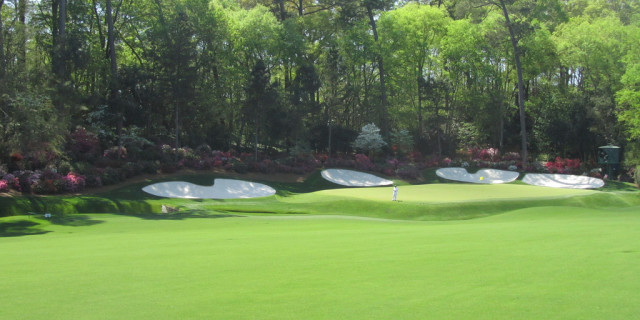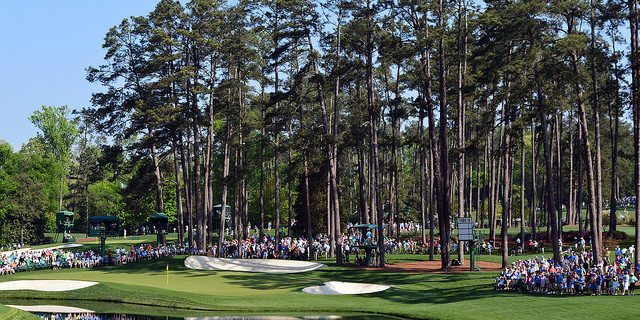
Tour all 18 Holes at Augusta National
Post by Sports Writer Derek Clements
AUGUSTA NATIONAL is a work in progress, a golf course that is instantly recognisable yet always changing and adapting to respond to the distance players hit the ball. Bunkers that were once real and genuine hazards are taken out of play by golfers who can clear them with ease, so tees are pushed back. Augusta never stands still.
The moment the inaugural tournament concluded in 1934, club officials started looking at how the course could be improved. They reversed the nines, then spent the next few summers chopping away at selected holes with shovels and axes, under the direction and approval of co-designer Bobby Jones, the retired legendary amateur who co-founded the club.
And so it went on. Past champions, renowned course architects, even longtime Masters chairman Clifford Roberts all suggested modifications that were implemented. As time ticked on, holes were further altered to address playability, agronomics, spectator convenience and club and ball technology.
It is easy to lose track of all the tweaks and alterations, so here is a reminder of how the course looks today before the 2017 Masters Tournament.
https://www.youtube.com/watch?v=0GdSCVN2lyg
No. 1 – Tea Olive
Yards: 445 Par: 4
This slight dogleg right plays uphill and has a deep bunker that calls for a 317-yard carry off the tee. The bunker has a tongue in the left side, so anything that enters the front of the bunker might be blocked by the lip. A bunker is left of the green, which falls off sharply at the back and to the right.
No. 2 – Pink Dogwood
Yards: 575 Par: 5
A dogleg left that can be reached in two by the big hitters, and was the scene of an albatross by Louis Oosthuizen in 2012. A fairway bunker on the right comes into play. A big drive kept down the left side shortens the hole, but leaves a downhill lie to a green guarded by two deep bunkers in the front.
No. 3 – Flowering Peach
Yards: 350 Par: 4
One of the best short par fours in golf, this hole that hasn't been changed since 1982. Big hitters can drive near the green, but not many try because of the trouble surrounding the L-shaped green that slopes sharply from right to left. Most players hit iron off tee to stay short of four bunkers on the left side.
No. 4 – Flowering Crab Apple
Yards: 240 Par: 3
A brutal par three that calls for a long iron or even a fairway wood. A deep bunker protects the right side of the green, with another bunker to the left. Club selection remains crucial because of the deceptive wind. The green slopes to the front. This hole features the only palm tree on the course.
No. 5 – Magnolia
Yards: 455 Par: 4
An uphill, slight dogleg to the left with two very deep bunkers guarding the left side some 300 yards from the tee. The green slopes severely from back to front, and a small bunker catches anything long. If an approach is long and misses the bunker, it could roll down the slope and into the magnolia trees.
No. 6 – Juniper
Yards: 180 Par: 3
An elevated tee to a large green with three tiers, with significant slopes marking the three levels. Getting close to the hole is a challenge. The easiest pin might be front left. The hole has not been changed since 1975. And no wonder. There is trouble left and right of the green.
No. 7 – Pampas
Yards: 450 Par: 4
This hole grown from 320 yards to 450 yards. The tee was extended by 40 yards in 2003, then two years ago the tee box was further lengthened. The drive played is through an avenue of Georgia pines, played to the left-centre of the fairway into a slight slope. The green is surrounded by five bunkers, the most around any green.
No. 8 – Yellow Jasmine
Yards: 570 Par: 5
An accurate drive is important to avoid the fairway bunker on the right side. The hole is uphill and features trouble left of the green. There are no bunkers around the green, just severe mounding.

No. 9 – Carolina Cherry
Yards: 460 Par: 4
The tee shot should be aimed down the right side for a good angle into the green, which features two large bunkers to the left. Any approach that is short could spin some 25 yards back into the fairway. The green slopes severely from back to front.

No. 10 – Camellia
Yards: 495 Par: 4
A long hole that can play shorter if the drive catches the slope in the fairway. It is difficult to save par from the bunker right of the green. The putting surface slopes from right to left. It has played as the most difficult hole in Masters history.

No. 11 – White Dogwood
Amen Corner
Yards: 505 Par: 4
Amen Corner starts here. The hole was lengthened by 15 yards in 2006, but some pine trees have been removed on the right side, although the landing area is still tight. A big tee shot is required to get to the crest of the hill. A pond guards the green to the left (and has claimed many victims over the years) and a bunker is to the back right. The safe shot is to bail out short and to the right, from where Larry Mize famously holed a chip to beat Greg Norman.

No. 12 – Golden Bell
Amen Corner
Yards: 155 Par: 3
One of the most famous par threes in golf, and is the shortest hole at Augusta National. Club selection can range from a 6-iron to a 9-iron, but it's difficult to gauge the wind. Rae's Creek is in front of the shallow green, with two bunkers behind it and one in front. This is where Jordan Spieth famously came to grief in 2016, hitting two balls into the water.

No. 13 – Azalea
Amen Corner
Yards: 510 Par: 5
An accurate tee shot to the centre of the fairway sets up players to go for the green. A tributary to Rae's Creek winds in front of the green, and four bunkers are behind the putting surface. From tee to green, there are about 1,600 azaleas. Relatively straightforward hole.

No. 14 – Chinese Fir
Yards: 440 Par: 4
The only hole on the course without a bunker. Even if the drive avoids trees on both sides of the fairway, the green has severe contours that feed the ball to the right.
No. 15 – Firethorn
Yards: 530 Par: 5
A cluster of pines dominates the right side of the fairway, making it critical to be straight off the tee. The green can be reached in two with a good drive, but a pond guards the front and there is a bunker to the right. Even for those laying up, the third shot requires a precise wedge. Anything that goes too long leaves a wicked pitch.
No. 16 – Redbud
Yards: 170 Par: 3
The hole is played entirely over water and eventually bends to the left. Two bunkers guard the right side, and the green slopes significantly from right to left. The Sunday pin typically is back and on the lower shelf, and pars from the top shelf that day are rare. A hole that always produces plenty of final-day drama.

No. 17 – Nandina
Yards: 440 Par: 4
The only major change to the course was not by design. The Eisenhower Tree to the left of the fairway about 210 yards from the tree could not be saved from an ice storm in February 2014 and was removed. It makes the tee shot much easier, especially for those with a lower, left-to-right ball flight. The green is protected by two bunkers in the front.
No. 18 – Holly
Yards: 465 Par: 4
Now among the most demanding finishing holes in golf, this uphill dogleg right is protected off the tee by two deep bunkers at the left elbow — the only bunkers in play off the tee on the back nine (except for par 3s). Trees get in the way of a drive that strays to the right. A middle iron typically is required to a two-tiered green that has a bunker in front and to the right.


Be part of the action with a selection of unique golf tournament experiences, from playing in a pro-am with the stars to watching the action at golf’s most illustrious events. Whether it’s the Masters or The Open, The Ryder Cup or WM Phoenix Open, build your own bespoke package with the experts at Golfbreaks.com.
What do you think? post your thoughts and feedback on the Golfshake comments: jump to comments here.
Tags: Masters Augusta National









